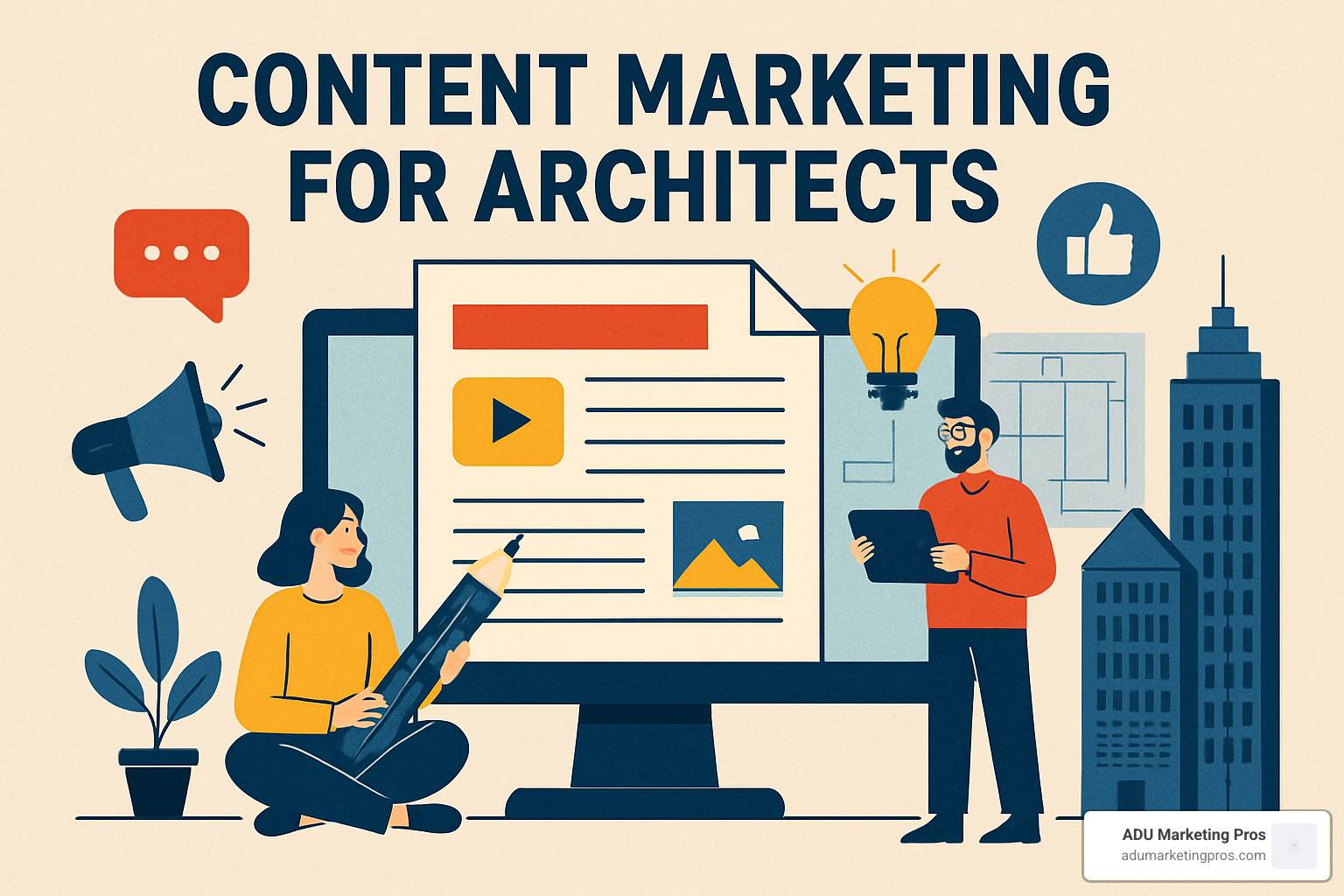Why Content Marketing is Essential for Modern Architecture Firms
Content marketing for architects is a strategic approach to creating and sharing valuable information that educates potential clients, builds trust, and positions your firm as the go-to expert in your market. Unlike traditional advertising, content marketing focuses on helping prospects understand complex design processes, steer regulations, and make informed decisions about their projects.
Key Components of Content Marketing for Architects:
- FAQ Content – Answer common client questions about permits, costs, and timelines
- Insider Insights – Share industry knowledge about zoning laws, design trends, and best practices
- Pain Point Solutions – Address project challenges like budget overruns and construction delays
- Visual Storytelling – Use before/after photos, 3D renderings, and project walkthroughs
- Educational Resources – Create guides, checklists, and case studies that demonstrate expertise
The numbers tell a compelling story. Research shows that 91% of potential architecture clients are in the information-gathering phase when they first find your firm online. These prospects aren’t ready to hire yet – they’re researching, learning, and building trust with firms that provide helpful content.
A robust content marketing strategy can increase your firm’s brand awareness by up to 86% and boost credibility by 75%. With 95% of people never looking past the first page of Google search results, architects who consistently publish valuable content have a massive advantage over competitors who rely solely on referrals.
The shift is clear: today’s clients expect to find answers online before they pick up the phone. Firms that accept this reality and position themselves as helpful guides – rather than gatekeepers – win more projects at better margins.

Why 2024 Demands a New Marketing Mindset
The architecture field is projected to grow 2.2%—a sharp jump from the 0.5% pace of recent years. More opportunity also means more firms vying for the same work.
Digital leaders already hold the advantage: 86% of firms that invest in online marketing see stronger brand awareness and 75% report higher credibility within 12 months. Those wins translate into qualified leads and healthier margins.
The shift is part of a bigger trend. Digital marketing has ballooned to a $460 billion industry and is tracking toward $786 billion by 2026, proof that clients vet architects online first.
Mobile-first behavior makes that vetting constant. Prospects browse your site on a phone at lunch, compare you with competitors during a commute, and shrink short-lists long before calling.
Tech expectations are rising too. VR walkthroughs, AI renderings, and interactive 3D models are becoming baseline, not bonuses. Firms that offer these experiences close more deals.
Most important is a cultural change: modern architects can accept entrepreneurship without sacrificing ethics. Content marketing for architects isn’t pushy sales; it’s teaching, guiding, and proving value at every step.
Latest research on digital marketing stats underscores the point: firms that invest strategically pull ahead, while referral-only models fall behind.
Content Marketing for Architects: The 5-Step Framework
Here’s the fundamental difference between traditional marketing and content marketing for architects:
| Traditional Marketing | Content Marketing |
|---|---|
| Interrupts prospects with ads | Attracts prospects with helpful information |
| Focuses on firm achievements | Focuses on client needs and challenges |
| One-way communication | Two-way engagement and relationship building |
| Short-term campaigns | Long-term trust and authority building |
| Difficult to measure ROI | Clear metrics and performance tracking |
Instead of chasing clients with award announcements, you publish resources that draw them to you when they need answers. The role shifts from salesperson to trusted advisor.
What Makes Content Marketing for Architects Different?
Architectural services are intangible, the sales cycle is long, and decisions are high-ticket. Prospects research for months, so your visuals, stories, and regulatory know-how must build confidence while they wait. Photos, renderings, and clear explanations turn complex codes into understandable steps and keep your firm top of mind.
Step 1: Identify & Segment Your Audience
Group prospects by project type and motivation. A first-time homeowner planning an ADU worries about permits and budget, while a developer cares about ROI and zoning speed. Build personas from real conversations—tools like Insight7 make the process fast.
Step 2: Map the Three Must-Have Topic Buckets
Organize every piece of content into one of three categories that match the client journey:
- FAQ answers – the exact questions they Google.
- Insider insights – zoning updates, sustainability trends.
- Pain points – budget overruns, difficult sites.
This structure positions your firm as the guide clients are searching for. More detail lives in our Online Marketing for Architects guide.
Step 3: Produce Optimized, Evergreen Assets
Prioritize assets with the longest shelf life:
- 1,500–2,500 word blogs targeted to specific SEO phrases.
- Case studies with before/after photos and testimonials.
- Short smartphone videos answering common questions.
- Quarterly webinars or downloadable checklists.
Optimize each with natural keywords and internal links. For SEO fundamentals see Scientific research on SEO basics.
Step 4: Distribute & Amplify Smartly
Great content needs reach. Repurpose one article into social snippets, email highlights, LinkedIn posts, and a guest article; then schedule it with automation tools. Our Email Marketing for Architects playbook walks through the workflow.
Step 5: Measure, Learn, Improve
Connect Google Analytics, Search Console, and your CRM to track:
- Search traffic and on-page engagement.
- Email opens and guide downloads.
- Leads, CAC, and LTV.
Use A/B tests and content scorecards to double down on what performs and trim what doesn’t.
SEO & Thought-Leadership Toolbox

Think of search engine optimization as the bridge between your brilliant architectural insights and the clients who desperately need them. When someone types “Do I need permits for my ADU?” at 11 PM on a Sunday night, your content marketing for architects strategy should ensure they find your helpful guide, not your competitor’s.
Keyword research is where most firms get it wrong. They optimize for terms like “award-winning residential design” when prospects actually search for “ADU architect near me” or “how much does an architect cost.” Tools like Google Keyword Planner reveal these real search patterns. The magic happens when you find that “ADU design requirements” gets 2,400 monthly searches while “contemporary architectural services” gets just 90.
Your content needs to think big to rank well. Long-form guides of 3,000+ words consistently outperform short articles because they provide comprehensive value. A detailed guide titled “Complete ADU Permit Process in San Jose” can rank for dozens of related searches like “ADU setback requirements,” “accessory dwelling unit fees,” and “California ADU laws.”
Internal linking turns your website into a helpful resource hub rather than a collection of random pages. When you write about ADU design considerations, link to your case studies, cost calculators, and permit guides. This keeps visitors engaged longer and signals to Google that your content is interconnected and valuable.
Building backlinks doesn’t require expensive PR campaigns. Guest posting on local business blogs, partnering with contractors for resource exchanges, and creating genuinely useful content that other professionals want to reference builds authority naturally.
Technical optimization might sound intimidating, but it’s really about making your content accessible. Fast-loading pages, mobile-friendly designs, and proper schema markup help search engines understand and display your content effectively.
Pillar pages anchor your thought leadership by covering broad topics comprehensively, then linking to specific subtopic articles. Your main “ADU Design Guide” pillar page might link to separate articles about zoning requirements, cost considerations, and construction timelines.
The goal isn’t just traffic – it’s attracting qualified prospects who see you as the knowledgeable guide they need. When your content consistently answers their questions and solves their problems, trust builds naturally.
For comprehensive website optimization that supports your content strategy, explore our Architect Website Design services. You’ll also find valuable insights through Business of Architecture insights that complement your SEO efforts.
Scientific research on SEO basics confirms what we see with our clients: consistent, helpful content combined with solid technical optimization creates lasting competitive advantages.
Social Media & Distribution Amplifiers

Social media is where your content comes to life through visuals and conversation. Think of each platform as a different room in your digital studio:
- Instagram – showcase project photos, behind-the-scenes reels, and quick tips.
- LinkedIn – publish longer thought-leadership articles for commercial and professional audiences.
- Pinterest – curate boards of design inspiration that homeowners often save months before hiring.
- Facebook – build community with detailed project albums and local news.
Short videos, even those filmed on a phone, outperform static images for engagement. Add VR demos or 3D walkthroughs when available to set your firm apart.
Encourage user-generated content by giving clients a project-specific hashtag and resharing their photos.
For consistency without extra workload, lean on these AI-powered helpers:
- Canva – quick graphics.
- Grammarly – error-free copy.
- Notion AI – idea generation.
- Zapier – cross-posting automation.
- Brand24 – engagement monitoring.
- Lexica Art – placeholder visuals.
- Headlime – scroll-stopping headlines.
Quality beats quantity: a steady cadence of genuinely helpful posts wins over rapid-fire updates.
Metrics, ROI & AI-Powered Optimization

Here’s the truth about content marketing for architects: if you’re not measuring it, you’re just guessing. The good news? The numbers tell an incredibly compelling story when you track the right metrics.
Conversion funnel analysis shows exactly how your content moves prospects from curious browsers to paying clients. At the top of your funnel, you’ll track blog traffic and social media reach – these numbers show how many people are finding your expertise. The middle of your funnel reveals the real magic: email signups, content downloads, and case study views indicate genuine interest.
The bottom of your funnel is where content marketing pays off. Prospects who’ve consumed multiple pieces of your content arrive at consultation requests already educated and pre-sold on your approach. They’re not shopping for the cheapest option – they want to work with the expert who helped them understand their project.
Marketing Qualified Lead tracking separates tire-kickers from serious prospects. Someone who downloads your ADU planning guide, reads three blog posts, and signs up for your newsletter represents a dramatically different opportunity than a casual website visitor. These engaged prospects convert at much higher rates and typically become better clients.
The email marketing ROI of 4,200% makes newsletters one of your most powerful tools. When you consistently deliver valuable content to subscribers’ inboxes, you stay top-of-mind throughout their lengthy decision-making process. Many architects find their best projects come from prospects who followed their content for months before reaching out.
AI-powered optimization is changing how smart firms operate. Chatbots handle initial questions on your blog posts and service pages, capturing lead information while providing instant help. Tools like LookX renderings create stunning visualizations that make your content more engaging and shareable.
Automated dashboards pull together data from Google Analytics, your email platform, and social media accounts. Instead of logging into five different systems, you can spot trends and optimization opportunities at a glance. This makes it much easier to double down on what’s working and fix what isn’t.
The most successful firms track their Customer Acquisition Cost (CAC) and Lifetime Value (LTV) to understand the true impact of their content investment. When you know that your average client is worth $50,000 and your content marketing costs $500 per new client acquisition, the ROI becomes crystal clear.
For architects ready to implement systematic lead generation alongside their content strategy, our Lead Generation for Architects services provide the complete framework for measurable growth.
Frequently Asked Questions about Content Marketing for Architects
How long before content marketing shows results?
Here’s the honest truth about content marketing for architects: you’ll start seeing some early wins around the 3-6 month mark, but the real magic happens between 6-12 months of consistent publishing.
Think of it like planting a garden. Those first few months, you’re putting in the work without much visible progress. But once your content starts taking root in search engines, something beautiful happens – your articles begin attracting prospects on autopilot.
The compounding traffic effect is what makes content marketing so powerful for architecture firms. That detailed guide you write today about ADU permit requirements? It could still be generating qualified leads for your firm three years from now. We’ve seen blog posts written by our California clients continue bringing in prospects long after they were published.
Unlike paid ads that stop working the moment you stop paying, quality content keeps working around the clock. It’s like having a knowledgeable team member who never sleeps, always ready to answer prospects’ questions and showcase your expertise.
Which content formats convert best for architects?
After working with dozens of architecture firms, we’ve noticed some clear patterns in what actually moves the needle.
Case studies consistently outperform almost everything else. There’s something powerful about reading how you solved a tricky zoning issue or transformed a challenging site into a beautiful home. Prospects can picture themselves in similar situations and start imagining what you could do for their project.
Video tours create an emotional connection that photos alone can’t match. Even a simple smartphone walkthrough of a completed ADU can be incredibly persuasive. People want to see spaces in motion, understand how rooms flow together, and get a feel for the quality of your work.
Downloadable guides work like magnets for serious prospects. When someone takes the time to download your “ADU Planning Checklist” or “Permit Timeline Guide,” they’re raising their hand and saying they’re genuinely interested. These resources also position you as the helpful expert rather than just another firm trying to sell services.
The key is mixing educational content with emotional storytelling. Give people the information they need while helping them envision their dream project becoming reality.
How much content should we publish each month?
We get this question a lot, and the answer might surprise you – it’s not about churning out content as fast as possible.
Most successful architecture firms we work with publish 2 solid SEO-optimized blog posts each month, along with weekly social media updates and a comprehensive guide or detailed case study every quarter.
Quality beats quantity every single time. Two well-researched, genuinely helpful articles will attract more qualified prospects than ten rushed posts about your latest awards or industry news that nobody searches for.
Here’s what we’ve learned works best: pick topics your prospects are actually Googling, then create the most thorough, helpful resource on that subject. Answer all their questions in one place. Include photos, examples, and practical tips they can use right away.
Your prospects don’t need more content – they need better content that actually helps them move forward with their projects. Focus on being genuinely useful, and the leads will follow naturally.
Conclusion

The world of architecture has changed dramatically, and content marketing for architects isn’t just a nice-to-have anymore – it’s essential for survival and growth. The days when architects could rely solely on word-of-mouth referrals are fading fast, replaced by a digital-first landscape where 91% of your prospects are already researching online before they ever pick up the phone.
The five-step framework we’ve walked through together provides your roadmap to success. Start by identifying and segmenting your audience so you’re speaking directly to homeowners planning ADUs versus developers managing large projects. Then map your content to those three essential buckets – answering FAQs, sharing insider insights, and solving real pain points your clients face every day.
Next comes the creation phase: produce optimized, evergreen assets that keep working for you months and years after you publish them. A comprehensive guide about ADU permits today could generate hundreds of qualified leads over the next few years. Then distribute and amplify smartly across email, social media, and other channels where your prospects spend their time. Finally, measure, learn, and improve using real data to refine what’s working and fix what isn’t.
The magic happens when prospects find your helpful content at exactly the moment they need it most. Maybe they’re wondering about zoning requirements at 11 PM on a Sunday, or trying to understand construction timelines during their lunch break. When your expertise is there to guide them, something powerful occurs – trust begins to build.
That trust transforms everything about your business relationships. Instead of competing primarily on price, you’re chosen for your expertise and guidance. Instead of chasing leads, qualified prospects come to you already believing in your capabilities. Instead of explaining what you do, you’re having deeper conversations about how you’ll solve their specific challenges.
The architecture industry’s digital change presents a massive opportunity, but only for firms that act decisively. While others hesitate or stick to traditional approaches, you can capture that vast majority of prospects who start their journey online.
This isn’t about becoming a marketing expert overnight – it’s about consistently showing up as a helpful guide for people navigating complex decisions. When you do that authentically and strategically, the projects follow naturally.
At ADU Marketing Pros, we’ve seen California architecture firms transform their practices by implementing these content marketing for architects strategies. The firms that commit to this approach don’t just survive the changing landscape – they thrive in it, attracting better clients and building more profitable relationships.
Ready to position your firm as the trusted guide your prospects are searching for? Our comprehensive ADU marketing solutions can help you implement these strategies without the overwhelm, so you can focus on what you do best – creating exceptional architectural solutions.




